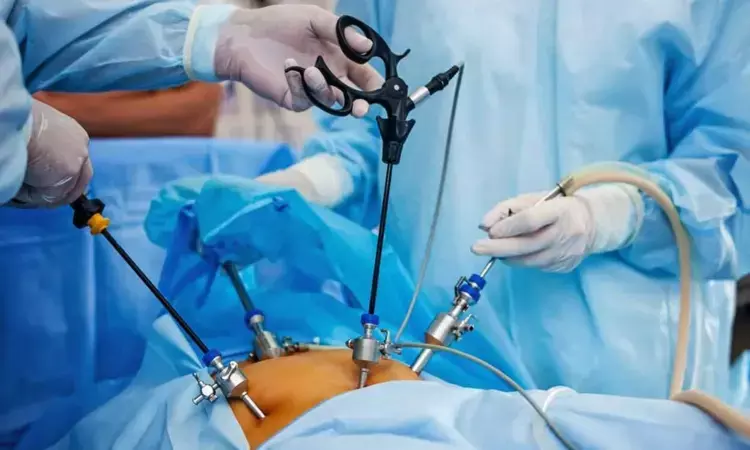- Home
- Medical news & Guidelines
- Anesthesiology
- Cardiology and CTVS
- Critical Care
- Dentistry
- Dermatology
- Diabetes and Endocrinology
- ENT
- Gastroenterology
- Medicine
- Nephrology
- Neurology
- Obstretics-Gynaecology
- Oncology
- Ophthalmology
- Orthopaedics
- Pediatrics-Neonatology
- Psychiatry
- Pulmonology
- Radiology
- Surgery
- Urology
- Laboratory Medicine
- Diet
- Nursing
- Paramedical
- Physiotherapy
- Health news
- Fact Check
- Bone Health Fact Check
- Brain Health Fact Check
- Cancer Related Fact Check
- Child Care Fact Check
- Dental and oral health fact check
- Diabetes and metabolic health fact check
- Diet and Nutrition Fact Check
- Eye and ENT Care Fact Check
- Fitness fact check
- Gut health fact check
- Heart health fact check
- Kidney health fact check
- Medical education fact check
- Men's health fact check
- Respiratory fact check
- Skin and hair care fact check
- Vaccine and Immunization fact check
- Women's health fact check
- AYUSH
- State News
- Andaman and Nicobar Islands
- Andhra Pradesh
- Arunachal Pradesh
- Assam
- Bihar
- Chandigarh
- Chattisgarh
- Dadra and Nagar Haveli
- Daman and Diu
- Delhi
- Goa
- Gujarat
- Haryana
- Himachal Pradesh
- Jammu & Kashmir
- Jharkhand
- Karnataka
- Kerala
- Ladakh
- Lakshadweep
- Madhya Pradesh
- Maharashtra
- Manipur
- Meghalaya
- Mizoram
- Nagaland
- Odisha
- Puducherry
- Punjab
- Rajasthan
- Sikkim
- Tamil Nadu
- Telangana
- Tripura
- Uttar Pradesh
- Uttrakhand
- West Bengal
- Medical Education
- Industry
Comparative Long-Term Reintervention Risks in Uterine Fibroid Treatments: Recent Research Provides Insights

USA: A recent study conducted within an integrated healthcare system has shed light on the long-term risks of reintervention following surgical treatment for leiomyomas, also known as uterine fibroids. The research that analyzed data over several years provides valuable insights into the outcomes and challenges patients may face post-surgery.
The researchers reported greater risks for long-term reintervention after endometrial ablation, uterine artery embolization, and hysteroscopic myomectomy versus abdominal, laparoscopic, or vaginal myomectomy in women treated for uterine fibroids. The findings were published online in Obstetrics & Gynecology in its May 2024 issue.
Leiomyomas are benign tumors that commonly affect women of reproductive age, often causing symptoms such as pelvic pain, heavy menstrual bleeding, and reproductive issues. Surgical interventions, including myomectomy and hysterectomy, are frequently recommended for symptomatic relief when conservative treatments are ineffective.
Susanna Mitro, MD, Division of Research, Kaiser Permanente Northern California, Oakland, CA, and colleagues aimed to compare the long-term intervention risk across four uterus-preserving surgical treatments for leiomyomas and to assess the effect modification by sociodemographic factors in a prospective cohort study in an integrated health care delivery system.
For this purpose, they studied a cohort of 10,324 patients aged 18–50 with a first uterus-preserving procedure (laparoscopic, abdominal, or vaginal myomectomy [referred to as myomectomy]; endometrial ablation; hysteroscopic myomectomy; uterine artery embolization) after leiomyoma diagnosis in the 2009–2021 electronic health records of Kaiser Permanente Northern California.
Patients were monitored until they underwent reintervention (either a second uterus-preserving procedure or hysterectomy) or until the end of the study period. The Kaplan–Meier estimator was employed to compute the cumulative incidence of reintervention, while Cox regression models were utilized to determine hazard ratios for comparing reintervention rates across different procedures.
These models were adjusted for age, parity, race and ethnicity, body mass index (BMI), Neighborhood Deprivation Index, and year of treatment. Additionally, we evaluated whether demographic characteristics modified the effects observed.
The following were the key findings of the study:
· Median follow-up was 3.8 years. Index procedures were 18.0% hysteroscopic myomectomies, 16.2% uterine artery embolizations, 21.4% endometrial ablations, and 44.4% myomectomies.
· Accounting for censoring, the 7-year reintervention risk was 20.6% for myomectomy, 26.0% for uterine artery embolization, 35.5% for endometrial ablation, and 37.0% for hysteroscopic myomectomy; 63.2% of reinterventions were hysterectomies.
· Within each procedure type, reintervention rates did not vary by BMI, race and ethnicity, or Neighborhood Deprivation Index.
· Rates of reintervention after endometrial ablation, uterine artery embolization, and hysteroscopic myomectomy decreased with age, and reintervention rates for hysteroscopic myomectomy were higher for parous than nulliparous patients.
In conclusion, over more than seven years of follow-up, the researchers found that reintervention rates were lowest after myomectomy, followed by endometrial ablation, uterine artery embolization, and hysteroscopic myomectomy. Reintervention risk did not vary by BMI, race and ethnicity, or Neighborhood Deprivation Index but did vary for some procedures by parity and age.
"The results reveal significant and clinically relevant variations in long-term reintervention rates following the initial uterus-preserving treatment for leiomyomas," the researchers wrote.
Reference:
Mitro SD, Xu F, Lee C, Zaritsky E, Waetjen LE, Wise LA, Hedderson MM. Long-Term Risk of Reintervention After Surgical Leiomyoma Treatment in an Integrated Health Care System. Obstet Gynecol. 2024 May 1;143(5):619-626. doi: 10.1097/AOG.0000000000005557. Epub 2024 Mar 28. PMID: 38547478; PMCID: PMC11022990.
.
Dr Kamal Kant Kohli-MBBS, DTCD- a chest specialist with more than 30 years of practice and a flair for writing clinical articles, Dr Kamal Kant Kohli joined Medical Dialogues as a Chief Editor of Medical News. Besides writing articles, as an editor, he proofreads and verifies all the medical content published on Medical Dialogues including those coming from journals, studies,medical conferences,guidelines etc. Email: drkohli@medicaldialogues.in. Contact no. 011-43720751


